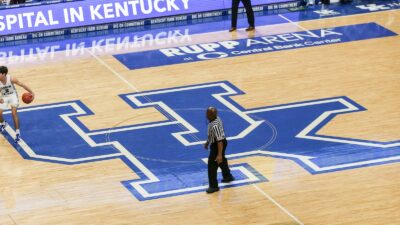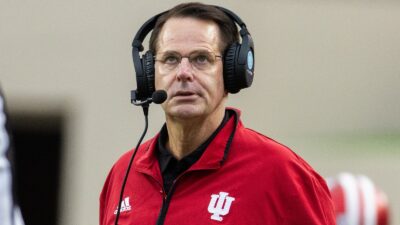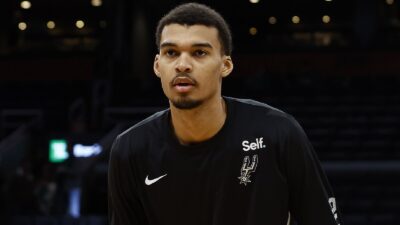
This year’s Final Four will be played inside NRG Stadium in Houston, which is the home of the Texans. Though it seems odd to shift from the more compact basketball arenas that typically seat fewer than 20,000 fans to a football stadium that has a capacity of over 70,000 fans, this has become the norm.
Since 1996, every Final Four has been played in a dome or football stadium. The Astrodome became the first dome to host a Final Four way back in 1971. The last true basketball arena to host a Final Four was New Jersey’s Continental Airlines Arena (now the Izod Center) in ’96.
In recent years, playing inside of a dome has become the rule and not the exception. So the question poses itself: Do the cavernous confines of a dome stadium impact the game negatively?
Let’s travel back to 2011 when Butler met UConn in the national championship game in Houston at the same venue, which was known as Reliant Stadium at the time. The horrific shooting display put on by the Bulldogs and Huskies is the go-to piece of evidence that proves massive multi-sport venues dramatically lower shooting percentages, particularly three-point shooting. Butler and UConn combined to shoot a putrid 31-for-119 (26 percent) from the floor that night, and 10-for-44 (22.7 percent) from deep. The Final Four performances from that same year were also on the lower end, with VCU-Butler and UConn-Kentucky checking in at a combined 88-218 (38.6 FG percentage) from the field. By any measure, on any stage, those shooting percentages were drastically below average. The numbers from that particular Final Four backed up the conventional wisdom that domes equal poor shooting.
However, history has proven otherwise when it comes to the effect of domes on shooting.
In the next four years, the Final Four was played at the Superdome, the Georgia Dome, AT&T Stadium and Lucas Oil Stadium. Each year, dating back to the last Final Four played in Houston, shooting percentages have risen inside of domes. In both 2014 and 2015, the shooting percentages in the Final Four actually exceeded the national average. Three-point shooting has been steady across the nation at 34-percent since 2010, while field goal percentages were 43.6 percent. As you can see below, the in-game performances in the most recent Final Fours are all within a few percentage points of that average.
2012 – Superdome (40.5 FG%, 36.8 3P%)
2013 – Georgia Dome (44.1 FG%, 35.9 3P%)
2014 – AT&T Stadium (45.2 FG%, 32.9 3P%)
2015 – Lucas Oil Stadium (45.8 FG%, 35.7 3P%)
Is the dome effect overblown? Perhaps. Four years of data only equates to 12 games, which is far from a meaningful sample size. What may be more useful for the upcoming Final Four is to examine all of the games played at NRG Stadium.
Since opening in 2002, the venue has played host to 12 NCAA Tournament games, including the aforementioned game between Butler and UConn. Here are the shooting averages from those games:
2008 – South Regional – 3 Games – (44.7 FG%, 31.2 3P%)
2010 – South Regional – 3 Games (40.1 FG%, 36.4 3P%)
2011 – Final Four – 3 Games (34.3 FG%, 28.1 3P%)
2015 – South Regional – 3 Games (39.7 FG%, 26.7 3P%)
Taken as a whole, it’s clear that NRG has some impact on teams, with players shooting 39.7 percent from the field and 30.7 percent from three-point range in the 12 games played at the venue. However, the 2011 Final Four is such a statistical outlier that it skews the overall numbers and has far too much impact on the so-called “NRG Effect.” If you remove the 2011 Final Four from this sample, the NRG average moves much closer to national averages, clocking in at 41.6 FG% and 31.8 3P%.
If you believe that the three-point shot is significantly impacted at NRG, then North Carolina is certainly the beneficiary of the venue’s impact.
The Tar Heels do not rely on the three-pointer in their offense, taking just 17.1 treys per game. Oklahoma, on the other hand, makes over ten threes per game, the fifth-highest reliance on the long distance shot in college basketball. Villanova and Syracuse both average just under nine threes made per game, so they’re not far off from the live-or-die with the three lifestyle. Syracuse’s obvious advantage over the field is that they play at the Carrier Dome, so the impact of NRG may be fairly minimal for the Orange.
Having three top-50 three-point shooting teams duke it out under the lights at NRG will do a lot to either dispel or confirm the “NRG Effect.” Buddy Hield, in particular, will test the dome shooting theory. The senior superstar is shooting 19-for-40 (47.5%) from long range in the Big Dance. If he falls victim to the “dome defense,” there may be no more point in denying it.













